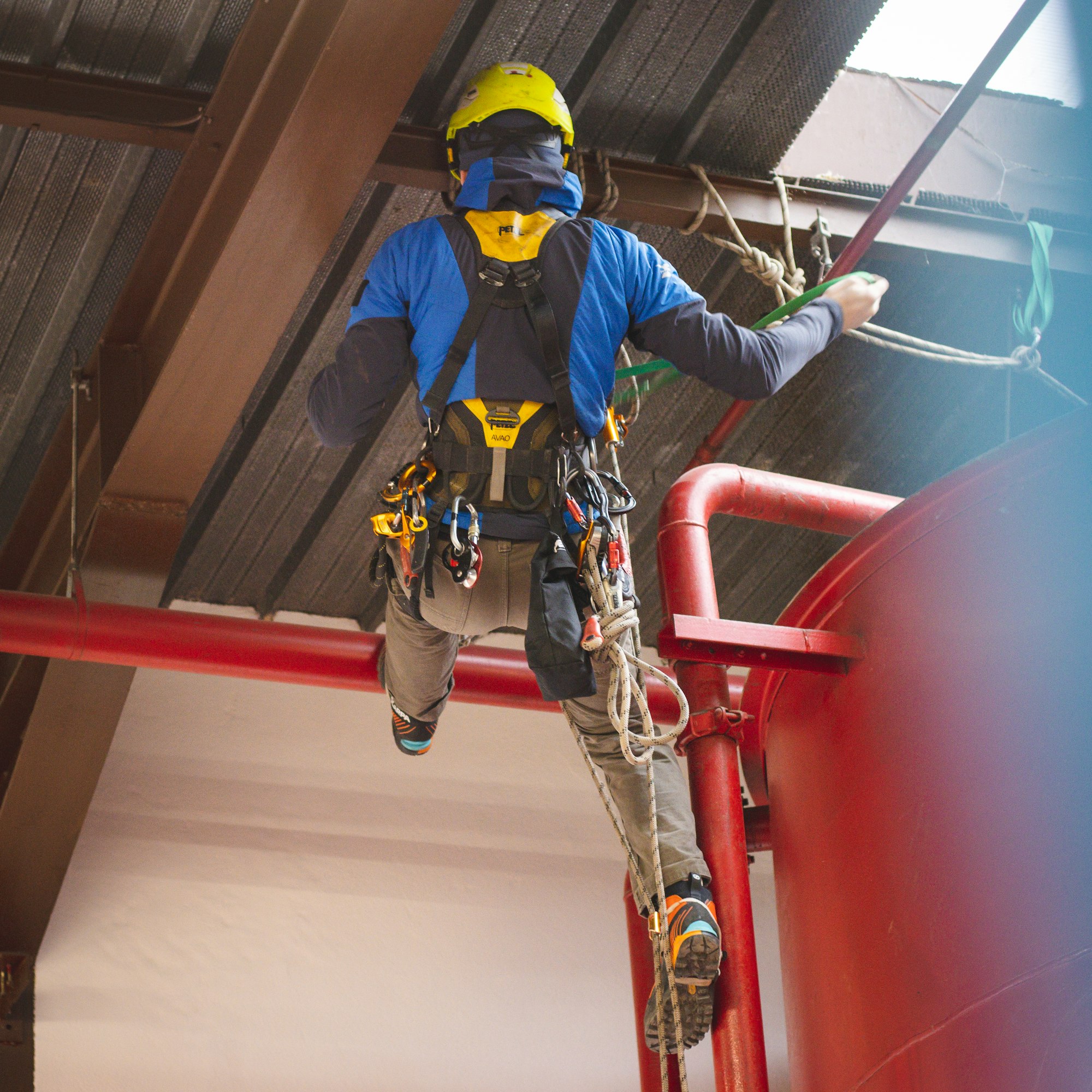IRATA Training

It can be challenging to make a living from rigging purely in the circus world because there’s a limited number of places to rig. One way to open new income opportunities is to become qualified in rope access, which in any case is useful in circus situations too.
The internationally recognised qualification body is IRATA – Industrial Rope Access Trade Association. It was set up originally for the offshore oil and gas sector and now awards qualifications across the world for people who work at height in repairs, inspections and maintenance in many industries.
The IRATA two-rope, fail-to-safe method of working has solved so many access problems around the world that the Association now has member companies in every continent.
IRATA doesn’t run training courses, it’s the regulatory body behind them, and it certifies people who have been on courses run by a variety of companies which teach the IRATA syllabus.
To find out what the course is like, we spoke to Steve Dawson, manager of Work at Height Training at Arco Professional Safety Services, which provides IRATA courses Levels One to Three. They have three training centres in the UK.
Who is IRATA training for?
People who are happy to work at height on rope systems in different industries and environments will get the most out of this course. The training will be invaluable for riggers in the circus and entertainment world, who need to access and move around rigs safely for inspection and maintenance as well as setting up rigging systems.
However, this is perhaps not a starting point for people who want to get into that specialism.
The IRATA syllabus is all about using the twin-rope system safely and in challenging circumstances, including rescuing yourself or a co-worker, whereas if you want to learn more about rigging itself, including a bit of rope access training, you’d be better doing the Rigging for the Entertainment Industry course with Chris Higgs at Total Solutions, or Bryan Donaldson’s Rigging Fundamentals for Aerial Performance course.
IRATA is great if you want to extend your skills in rope systems or you want to greatly enhance your employment opportunities. Rope access and rescue are used extensively for inspecting and maintaining equipment in multiple industries including oil and gas, civil engineering, maritime and more.
There are no specific requirements, you can start the Level One course with no experience.
How long are the courses?
You’ll do four days full-time training then the fifth day is when an independent assessor puts you through your paces. It’s the same whether it’s Level One, Two or Three, and if you revalidate whatever level you are at. The qualification is valid for three years.
Steve says: “It's not a turn-up-and-pass course. You might do the four days and actually you're not ready for the assessment, but those four days are still valid for 60 days. You might want to come back and do an extra day and then do the assessment. If you were to fail the assessment on the Friday, those four days are still valid.
“The assessor might say you're pretty much there, and recommend an extra bit of training on a couple of things, then do your assessment.”
There are six students per instructor, and it costs between £600 and £800 depending on the training provider.
Arco run courses every month at their three UK locations and there are other companies offering IRATA training throughout the UK and across the world.
What’s in Level One?
The whole range of personal fall protection systems are covered in an IRATA course. It just gets more complex as you move up levels.
Level One is the introduction to a rope access system which will get you to somewhere where you can do your job. Level One is keeping yourself safe whilst moving around on that rope-based system.
Steve says: “It is quite basic level if knowledge, but it's a tough course. It’s up and down ropes, getting to where you need to be, without too much in terms of complex rigging hauling systems.
“With Level One qualification, the idea is that you're going into a system whereby you should be able to rig up ropes with a bit of mentoring. You will always be under a supervisor who would be checking that the rescue is relevant, because a Level One isn't trained to rescue out of every scenario.”
The Level One course includes:
- Basic harness done in set-up so you've got all the equipment on your harness that you will need to pretty much perform any manoeuvre, bar a couple of climbing techniques.
- Ascending and descending on twin-line systems.
- Knot-tying for basic rigging.
- Basic anchor systems – figure of eights and nines and alpine butterflies, small wire hangs using different separated anchors.
- Rope manoeuvres such as passing people and going over edges, passing mid-rope knots and obstructions (if there was damage or joints and knots, you’d know how to get past those deviations).
- Use of mobile or fixed anchor points.
- Climbing and the use of fall arrest twin lanyards.
- Basic rope rescue of a co-worker – side-by-side working to get the co-worker onto you or you onto them and, and down safely.
- Use of a rig for rescue system, a lower-end system. You pre-rig ropes through a releasable system, and so you can lower someone off.
- Inspection, maintenance and documentation of equipment.
- Awareness of hauling, a typical three-to-one set-up (there’s no assessment on that part, it’s just useful to have that understanding).
What about the other levels?
In Level Two, you have more knowledge of hauling rescue scenarios and rigging systems. Steve says: “Level Two is definitely that more advanced level, which may suit your stage-type riggers better. “
Level Three makes you an advanced rope access technician, so there are harder versions of the syllabus and more training in planning and legal requirements to get people out of trouble. The Level Three syllabus covers a wide range of rescue scenarios, planning to have the most efficient, simple system for getting someone out of trouble.
Steve says: “If we get into high-end rope access, we can get ourselves into some pretty awkward places that emergency services aren't going to get to, so we've got to be self-sufficient.”
People sometimes assume that a Level Three rope technician is automatically at supervisor level. However, the working at height regulations state that while a supervisor is required, it’s up to individual companies to decide what competencies that supervisor needs. They may or may not need an element of soft skills, risk assessments, method statements etc, depending on the work at hand.
How do you progress up the levels?
It’s based around time served. When you qualify for each level, you need to log 1,000 hours and a minimum of one year of experience to be eligible for the next level. Logging that many hours in the circus world alone would be very challenging within a year and even within three years. But Level One qualification would probably be all you’d need unless you want to make a career of rope access work.
Steve says: “Someone who moves into the rope access world and is on the ropes every week, then they could build up those hours within a year. It’s doable. But one year is the minimum.
“You can revalidate your Level One or Level Two every three years and log the hours over a longer time. Those hours ideally need to be verified by a Level Three rope access supervisor.
“They do recognise that if you are using a twin-rope system whether or not you are working for a non-IRATA company, maybe you're doing rigging or staging, you can log those hours and you will normally get the manager, supervisor, or director to sign off those hours. If you've got those contact details in that logbook, they can be verified if needs be. It could potentially be questioned from the IRATA assessor if you’ve never worked with a Level Three supervisor.
Alternative to IRATA for circus people…
Arco offer another course, called Access for Theatre Technicians, running for two days at Level One and three days at Level Two. It’s a basic work-at-height and rescue course designed for the theatre.
These are for six people at the same company, and they are run at the client’s site. It’s adapted for the specific needs of that company’s operation.
Steve says: “Normally stagehands need to get to different parts of the stage and rigging that, once that show has been built and set up, it's difficult to reach without some sort of rope access. So we cater for that, make it a bit bespoke.”

